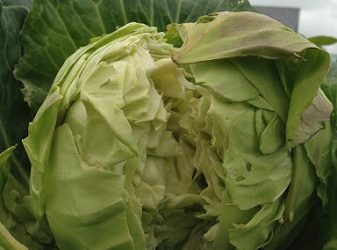Black Rot in Cabbage.

Black Rot is caused by bacteria and can be identified on the leaf as a “V” shaped yellow colour, moving from the edge inwards and downwards into the stem. This symptom distinguishes Black rot from Fusarium wilt where symptoms move upwards from the soil level towards the stem.
As the disease progresses, the yellowing part of the leaf turns brown and the tissues die. Leaf veins turn black at the final stage of the disease.
Black rot is one of the most serious diseases of cabbage in Kenya. It poses a big problem in areas of high humidity, reducing crop yields by as much as 75-90%. The bacteria that cause Black Rot can survive and spread via wild hosts, soil, water droplets or infected seed.
How to manage the Disease:
– Avoid growing very susceptible varieties in the rainy season. There are no resistant varieties in Kenya.
– Do not plant cabbage in a field that has had cabbage, broccoli, cauliflower, kale or any other member of the Brassica family for the previous 3 years
– Avoid using overhead sprinklers because they can cause soil to splash on leaves and so will spread the disease
– Control weeds in and around the production area, especially weeds from the cabbage family
– Do not enter fields when they are wet to reduce the risk of transferring the disease from one leaf to another by moisture on the leaves
– Prune off all leaves close to the ground and leaves that show signs of the disease (use clean tools regularly dipped in bleach)
– Bury or burn all crop debris after harvest.
Chemical Control:
Spray Copper Hydroxide (e.g. Kocide 101, Champion, or Coback) on the entire plant, paying attention to the underside of the leaves.
When using a pesticide, always wear protective clothing and follow the instructions on the product label, such as dosage, timing of application, and pre-harvest interval.


